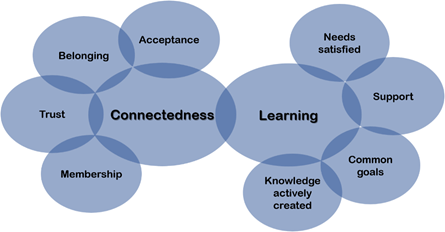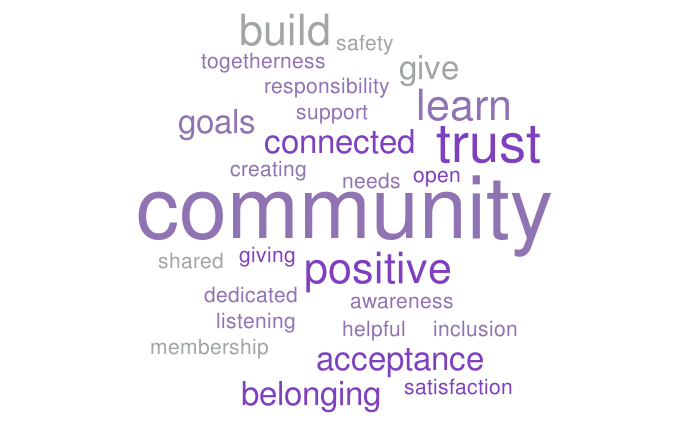Building Community
Intentionally building community within your classroom is a valuable endeavor and can enhance the climate of your classroom and learning and experience of your students. Whether your classroom is large, small, blended, or fully online, it is possible to strategically foster a strong community within your learning space.
What is community?
Community is built on relationships. The essential elements of a community, as defined in the realm of psychology, are membership, connection, influence, and needs fulfillment (McMillan, 1986). In the context of a university learning community, Rovai (2002) has identified two key elements: learning and connectedness, upon which grow the elements of a strong community.

Built upon Rovai’s (2002) definition of community in the context of a university course.
Why is community important?
 Building a community in your classroom is more than a warm feeling - it impacts the success of your students. A sense of community and positive classroom climate are related to student learning, persistence, and satisfaction.
Building a community in your classroom is more than a warm feeling - it impacts the success of your students. A sense of community and positive classroom climate are related to student learning, persistence, and satisfaction.
Student Learning
- A significant relationship has been identified between classroom community and perceived cognitive learning, learning engagement, and learning outcomes (Liu, Magjuka, Bonk & Lee, 2007; J. P. McKinney, McKinney, Franiuk, & Schweitzer, 2006; Rovai, 2002).
- Student involvement and courtesy are positively related to affective learning and perceived cognitive learning (Myers et al., 2015).
- Student-instructor and student-student connectedness in the classroom are linked to out-of-class communication and peer learning (Sidelinger, Bolen, McMullan & Nyeste, 2014).
Student Persistence/Retention
- Students who feel alienated and alone tend to withdraw, while connectedness is related to persistence (Tinto, 1975, 1993).
Student Satisfaction
- A positive relationship has been found between a sense of community and course quality satisfaction (Liu et al., 2007).
How can I foster community in my class?
Promote a Positive Classroom Climate
- Student feedback
- Set the tone. As the instructor, you can model the actions and attitudes you want in your class – share your enthusiasm, respect for others, and civility.
- Co-create expectations. On the first day of class, facilitate a discussion with your students specifically to identify positive behaviors and expectations that will help students feel safe, accepted, and valued. Consider creating a “Classroom Guidelines” list to post on your OWL site that you (and your students) can refer to during the term. This item may be of even greater importance for fully online classes, as Netiquette and engaging in a more formal, academic environment online may be new to some of your students.
- Respond. Seek feedback from your students throughout the term, and promptly address any issues if they arise.
Stimulate Student-Student Interactions
- Plan an Icebreaker. On the first day of class (and perhaps throughout the term), facilitate an activity that has students get to know one another in a fun, creative, relaxed way. For a large class, students can still introduce themselves and get to know those who sit around them. For an online class, get creative with the technology tools that allow students to interact with one another. Consider a VoiceThread (an OWL coursesite plugin) video introduction!
- Build interactivity into learning activities. Working collaboratively not only keeps students engaged, but also allows students to learn more deeply, provide one another with feedback, and challenge one another. For an online class, explore the many interactive technology tools available to reach specific learning outcomes. For a large class, have students explain a solution to their partner prior to sharing a solution yourself. See Active Learning for further ideas.
- Build interactivity into assessments. Would your students benefit from providing one another with feedback? Collaborating on a group presentation? Tapping one another’s experiences? Create opportunities for your students to work together to create something great.
Engage with Students
Student Comment (Tinto, 1997)
- Be personable and approachable. Let students know how they can contact you. Chat with your students before/during/after class. Show your students you care. For an online class, consider using audiovisual interactions so students can see and hear you, rather than only reading your text.
- Use student names. Learn your students’ names as quickly as possible (ask for their preferred name and pronunciation) and use them regularly. Consider using name tents to learn student names. Even for large classes – try to learn a few names each class!
- Accept questions. Make space for your students to ask questions and take action to respond to these questions. For an online course, consider creating a forum where students can ask questions and receive a response from you or their peers. For a larger class, use a short answer style question with an audience response software to gauge where students are struggling, and come back to the next class with extra support.
Recommended CTL Programs
- Advanced Teaching Program (ATP) (graduate students and postdoctoral scholars)
- Instructional Skills Workshop (ISW) (instructors, librarians, archivists)
- Instructional Sills Workshop Online (ISW-O) (instructors, librarians, archivists)
- Teaching in the Canadian Classroom (TCC) (international graduate students)
Questions?
If you would like to further discuss techniques for building community, please contact one of our educational developers.
References and Further Reading
Ehrman, M.E. & Dornyei, Z. (1998). Interpersonal dynamics in second language education: The visible and invisible classroom. Thousand Oaks, CA: Sage Publications.
Liu, X., Magjuka, R.J., Bonk, C.J. & Lee, S.h. (2007). Does sense of community matter? An examination of participants' perceptions of building learning communities in online courses. Quarterly Review of Distance Education, 8(1), 9-24.
Rovai, A. P. (2002). Sense of community, perceived cognitive learning, and persistence in asynchronous learning networks. Internet and Higher Education, 5, 319-332.
McKinney, J.P, McKinney, K.G., Franiuk, R. & Schweitzer, J. (2006) The college classroom as a community: Impact on student attitudes and learning. College Teaching, 54, 281-284.
McMillan, D.W., & Chavis, D.M. (1986). Sense of community: A definition and theory. Journal of Community Psychology, 14, 6-23.
Myers, S.A., Goldman, Z.W., Atkinson, J., Ball, H., Carton, S.T., Tindage, M.F. & Anderson, A.O. (2015). Student civility in the college classroom: Exploring student use and effects of classroom citizenship behavior. Communication Education, 65(1), 64-82. doi:10.1080/03634523.2015.1061197
Sidelinger, R.J., Bolen, D.M., McMullen, A.L. & Nyeste, M.C. (2014). Academic and social integration in the basic communication course: Predictors of students' out-of-class communication and academic learning. Communication Studies, 66(1), 63-84. doi:10.1080/10510974.2013.856807
Tinto, V. (1975). Dropout form Higher Education: A Theoretical Synthesis of Recent Research. Review of Educational Research, 45, 89-125
Tinto, V. (1993). Leaving college: rethinking the causes and cures of student attrition. (2nd ed.). Chicago: University of Chicago Press.
Tinto, V. (1997). Classrooms as communities: Exploring the educational character of student persistence. The Journal of Higher Education, 68(6), 599-623. doi:10.1080/00221546.1997.11779003
Vesely, P., Bloom, L., & Sherlock, J. (2007). Key elements of building onlne community: Comparing faculty and student perceptions. Journal of Online Learning and Teaching, 3(3). Retrieved from http://jolt.merlot.org/vol3no3/vesely.htm.
